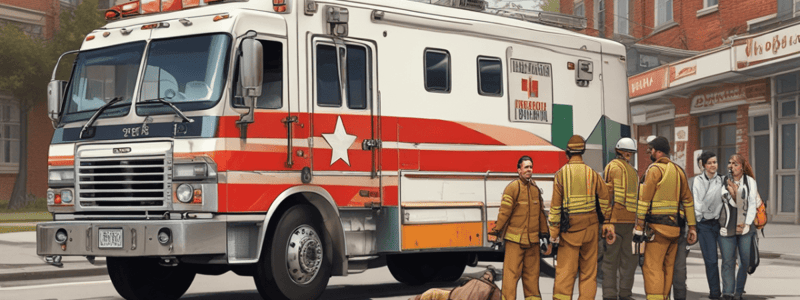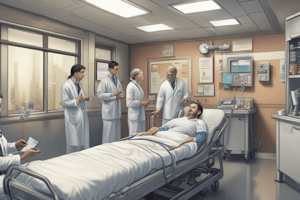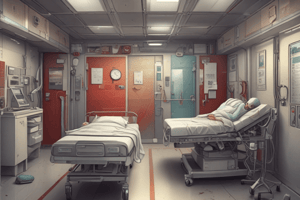Podcast
Questions and Answers
In a medium to large scale incident, how many of the most critical patients should be transported to each hospital reachable within 30 minutes?
In a medium to large scale incident, how many of the most critical patients should be transported to each hospital reachable within 30 minutes?
- 2 (correct)
- 3
- 1
- 4
Which of the following is NOT a piece of information that should be provided to the NWCH in a medium to large scale incident?
Which of the following is NOT a piece of information that should be provided to the NWCH in a medium to large scale incident?
- The name of the person who called 911 (correct)
- Types of illness/injuries
- Estimated number of patients at the incident site
- Estimated patient category: # red, yellow, green, deceased
In a medium to large scale incident, what happens to the usual transport patterns?
In a medium to large scale incident, what happens to the usual transport patterns?
- They are modified to prioritize critical patients.
- They are completely disregarded. (correct)
- They are used as a guideline but can be adapted based on the situation.
- They are strictly enforced.
What is the first step in the event of a large-scale transportation management incident, according to the text?
What is the first step in the event of a large-scale transportation management incident, according to the text?
Which of the following statements is TRUE regarding patient transport in a medium to large scale incident?
Which of the following statements is TRUE regarding patient transport in a medium to large scale incident?
Which of the following is a responsibility of the Transportation Officer?
Which of the following is a responsibility of the Transportation Officer?
Which of the following statements about the triage process in a medium to large scale incident is TRUE?
Which of the following statements about the triage process in a medium to large scale incident is TRUE?
What is the maximum number of green victims that XYZ hospital can accept?
What is the maximum number of green victims that XYZ hospital can accept?
In a medium to large scale incident, what is the role of the NWCH (Northwestern Central Hospital)?
In a medium to large scale incident, what is the role of the NWCH (Northwestern Central Hospital)?
Which of the following information is NOT provided by the NWCH to potential receiving hospitals in a medium to large scale incident?
Which of the following information is NOT provided by the NWCH to potential receiving hospitals in a medium to large scale incident?
What is the specific communication method recommended in the event of a large-scale incident, even before patient information is finalized?
What is the specific communication method recommended in the event of a large-scale incident, even before patient information is finalized?
In a medium to large scale incident, what does the NWCH provide to the hospitals in addition to coordinating the response?
In a medium to large scale incident, what does the NWCH provide to the hospitals in addition to coordinating the response?
What is the correct communication protocol for individuals involved in a large-scale incident?
What is the correct communication protocol for individuals involved in a large-scale incident?
Who designates the Staging Area Manager?
Who designates the Staging Area Manager?
What is the specific instruction regarding contacting dispatch in the context of a large-scale incident?
What is the specific instruction regarding contacting dispatch in the context of a large-scale incident?
Which of the following is NOT listed as a municipality within the Region IX command area of Northwest Community Hospital?
Which of the following is NOT listed as a municipality within the Region IX command area of Northwest Community Hospital?
What is the primary responsibility of the Staging Area Manager?
What is the primary responsibility of the Staging Area Manager?
What information does the Staging Area Manager maintain an accurate log of?
What information does the Staging Area Manager maintain an accurate log of?
What is the main purpose of assigning a Transportation Officer?
What is the main purpose of assigning a Transportation Officer?
Who requests specific ambulances with certain capabilities from the Staging Area Manager?
Who requests specific ambulances with certain capabilities from the Staging Area Manager?
What is the purpose of maintaining communication with the Medical Group?
What is the purpose of maintaining communication with the Medical Group?
What is the role of the first unit at the staging location?
What is the role of the first unit at the staging location?
What does the Staging Area Manager do upon request from the Medical Group Supervisor?
What does the Staging Area Manager do upon request from the Medical Group Supervisor?
What is ensured by the Staging Area Manager for all incoming units?
What is ensured by the Staging Area Manager for all incoming units?
In the event of a medium to large scale incident, what is the primary responsibility of the Triage Personnel, as outlined in the provided content?
In the event of a medium to large scale incident, what is the primary responsibility of the Triage Personnel, as outlined in the provided content?
Which of the following actions would be considered a responsibility of both the Triage Personnel and the Treatment Unit Leader?
Which of the following actions would be considered a responsibility of both the Triage Personnel and the Treatment Unit Leader?
Based on the provided information, what is the specific role of the Transportation Unit Leader in relation to the NWCH (Northwest Community Hospital)?
Based on the provided information, what is the specific role of the Transportation Unit Leader in relation to the NWCH (Northwest Community Hospital)?
Under what specific circumstance would the Treatment Unit Leader be designated during an incident?
Under what specific circumstance would the Treatment Unit Leader be designated during an incident?
Based on the information provided, which of the following is NOT a responsibility of the Treatment Unit Leader?
Based on the information provided, which of the following is NOT a responsibility of the Treatment Unit Leader?
According to the provided content, what is the primary responsibility of the Medical Group Supervisor?
According to the provided content, what is the primary responsibility of the Medical Group Supervisor?
Based on the provided content, what is the purpose of the triage tag retained by the Triage Personnel?
Based on the provided content, what is the purpose of the triage tag retained by the Triage Personnel?
Which of the following is a crucial step that is performed by both the Triage Personnel and the Treatment Unit Leader?
Which of the following is a crucial step that is performed by both the Triage Personnel and the Treatment Unit Leader?
Which of the following roles is primarily responsible for determining the level of documentation needed for each incident?
Which of the following roles is primarily responsible for determining the level of documentation needed for each incident?
In what scenario would the Medical Supply Officer likely be most actively involved?
In what scenario would the Medical Supply Officer likely be most actively involved?
Who is responsible for establishing a safe landing zone for an arriving helicopter?
Who is responsible for establishing a safe landing zone for an arriving helicopter?
Which of the following is NOT a primary responsibility of the Medical Group Supervisor?
Which of the following is NOT a primary responsibility of the Medical Group Supervisor?
If a large-scale incident occurs and additional supplies are needed, which of the following actions should be taken?
If a large-scale incident occurs and additional supplies are needed, which of the following actions should be taken?
Which of the following is NOT a type of medical supply or equipment typically managed by the Medical Supply Officer?
Which of the following is NOT a type of medical supply or equipment typically managed by the Medical Supply Officer?
Flashcards are hidden until you start studying
Study Notes
Practical Application for Medium to Large Scale Incidents
- START/JUMP start triage is required in medium to large scale incidents
- Triage tags are mandatory for patients
- Ambulances may transport more than one patient, with a maximum of: · 1 stretcher patient · 3 seated patients · 2 stretcher patients, with all occupants safely secured
- OLMC (Online Medical Control) may not be required when transporting patients; Rx per SOPs (Standard Operating Procedures)
- PCRs (Patient Care Reports) are optional; triage tags may be used instead
General Fire Department Responsibilities
- Contact the NWCH (Northwest Community Hospital) ASAP in a medium to large scale incident
- Provide the NWCH with essential information, including: · Nature of the incident · Incident site (e.g., nearest major intersection) · Closest hospitals (e.g., SAMC, Sherman Hospital, ABMC, or NWCH) · Estimated number of patients at the incident site · Estimated patient category (e.g., # red, yellow, green, deceased) · Hospitals already receiving patients · General age groups (pediatrics, adults, elderly) · Types of illnesses/injuries (e.g., blunt/penetrating trauma, burns, inhalation, toxins, biological/chemical exposure) · Any special needs (e.g., decontamination, medications for WMD, medical teams to the scene) · Exchange call-back numbers
Transportation Management
- NWCH will contact potential receiving hospitals and provide transportation management
- Receiving hospital capacities for accepting victims will be provided (e.g., "XYZ hospital can accept two red, four yellow, and six green victims.")
- A specially assigned Transportation Officer will establish and maintain direct contact with NWCH
Hospital Command
- Northwest Community Hospital will assume Hospital Command for the following areas: · Arlington Heights · Hoffman Estates · Prospect Heights · Barrington · Itasca · Rolling Meadows · Schaumburg · Des Plaines · Elk Grove Township · Palatine Rural
- First Alternate: Saint Francis Hospital
- Second Alternate: Highland Park Hospital
Important Notes
- ALL COMMUNICATION MUST GO THROUGH NWCH
- Do not attempt to contact the scene or dispatch directly
- Do not divert individual ambulances
Medical Supply Officer
- Appointed by the Medical Group Supervisor
- Secures and organizes medical supplies and equipment, including: · Backboards · Oxygen supplies · Dressings and bandages · Large dose medications · Volumes of sterile water · IV fluids and equipment
- May obtain additional supplies and equipment by requesting the mass casualty trailer to be brought to the scene
Triage Unit Leader
- Appointed by the Medical Group Supervisor
- Provides coordination necessary for effective categorization of patients
- Supervises triage personnel during the initial phase of a medium to large scale incident
- Determines and relays the number of patients and general acuity to the Medical Group Supervisor
- Reports any needs regarding equipment and manpower to the Medical Group Supervisor
Treatment Unit Leader
- Designated by the Medical Group Supervisor
- Establishes and manages a patient treatment area
- Frequently reassesses patients in the treatment area to determine the need for re-categorization
- Prioritizes patients for transport to hospitals
Transportation Unit Leader
- Designated by the Medical Group Supervisor
- Establishes loading of ambulances and records patient destinations
- Communicates with NWCH regarding patient numbers, triage categories, and hospital capabilities
- Establishes a patient loading area allowing for safe and coordinated access and egress of ambulances
- Notifies the destination hospital for each transporting ambulance
Staging Area Manager
- Designated by the Medical Group Supervisor
- Manages all incoming fire/rescue apparatus, ambulances, and other resources
- Maintains communication with the medical group (either Transportation or Treatment Unit Leader) to supply necessary ambulances
- Maintains communication with Incident Command to advise on available resources
- Sends requested resources to the scene
- Manages the staging area, ensuring orderly parking and maintaining clear access to the incident site
Studying That Suits You
Use AI to generate personalized quizzes and flashcards to suit your learning preferences.




